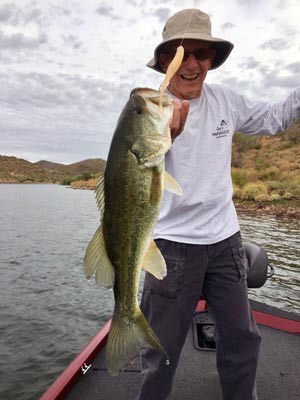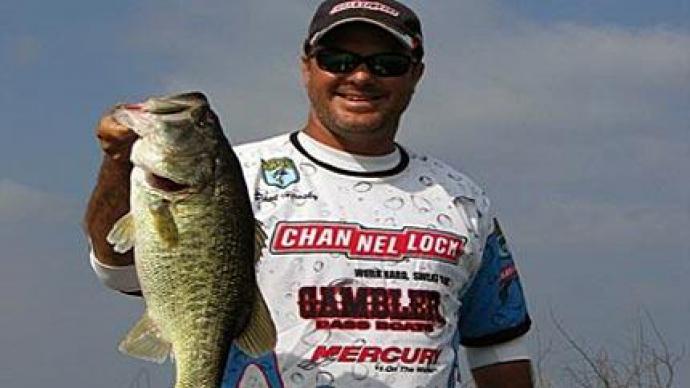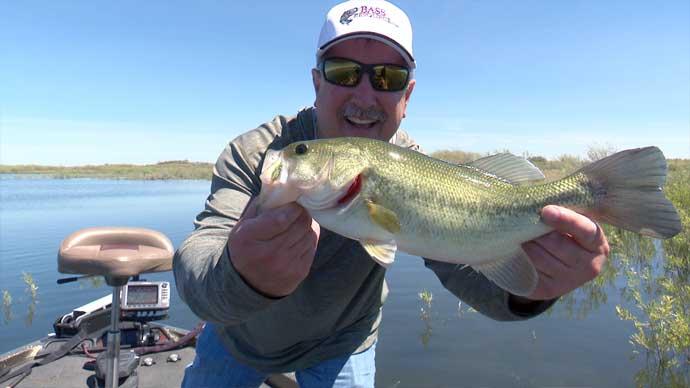
Swimbait is a broad term – it can mean anything from a grub to a 15-inch trout imitation. They are distinct from crankbaits in design and usually, in material – swimbaits tend to be made of softer stuff than crankbaits, but they are all designed to imitate some kind of baitfish. Spring is the perfect time to get acquainted with these baits if you aren’t already a fan, so here are some tips to help you improve your swimbait techniques.
D-Shad and Fluke Baits
These little baits are all the rage out West now, and they have been putting fish in the boat all year. Little Dippers, D-Shad, flukes – they come in a wide variety of colors, and the tails can be split, straight, paddle – you name it. No matter what kind you use, they flat-out catch fish. When the bass are up shallow and active, all you have to put one on a hook (rig it weedless), then throw it to shore and twitch it. But there are several things you can do to increase your catch ratio and save some money, whether you fish flukes or giants.
- Use a trailer hook. When you rig a fluke on a big worm hook, slip a large treble hook onto the hook before you push it back into the lure. Ensure that the treble is rigged correctly so that one of the hooks points right back at the bait. You can insert this into the bait and expose the other two hooks. When you’re twitching over open water, these aren’t going to snag on anything, but they make a difference in your catching, especially if the fish are short-striking.
- Put a bit of weight in front of it. If the fish are a bit deeper, you need to add weight to the lure to put it in front of them. A D-Shad is naturally a little heavier, but even a D-Shad may need to be deeper. Gary Dobyns got tired of jig heads that didn’t have decent barb systems, and when you’re fishing an A-rig or even a single bait, it gets expensive when they keep falling off. So he invented one himself. The Dobyns jighead has a 4-barb system that requires no super glue and makes the bait swim naturally but holds it on tight. Put it on straight the first time, or you’ll rip it up taking it off. It’s “stupid simple,” Gary says.
- Use braided line. If you’re fishing a small fluke bait, you need to be able to throw it, and you need to be able to set the hook hard and fast when the time comes. A braided line is perfect for this. If you’re fishing clear water, use a fluorocarbon leader and join them with a double uni. Aaron Martens will show you how to tie one here: https://www.bassresource.com/bass-fishing-videos/double-uni-knot.html
- Match the hatch. Like a fly fisherman, you need to be aware of what the fish are eating in the lake you’re fishing. The Game and Fish Department stocks catchable rainbow trout in some of our clear-water reservoirs out west. These tasty morsels make the bass grow big and fat. Throwing a trout swimbait is a dynamite way to tempt one of the big bass into biting. Shad are the primary prey on other lakes out west, like Pleasant and Mead. We just went to a new lake called Hidden Lake near Buckeye, Arizona, which is being managed as a trophy bass lake. It just opened in January. The owner told me that when the giant orange dragonflies are out, the bass will jump out of the water and grab them out of the air. I think an orange twitch bait would be perfect right about then.
- Put it where the fish are. If you’re too worried about losing your bait, you shouldn’t be fishing it. Matt Shura told me that he tries to throw his baits into stuff that worries him. He knows that bass love to hang out in the thick stuff, so that’s where to go after them. At Hidden Lake, he was casting into branches and submerged trees that you would swear he’d never get out of. But that’s where he caught the big fish.
- Don’t be afraid to change it up. If you think the tail on your swimbait could use a little more action, take a knife to it and carve away until the tail wiggles like you want it to. Try a little dye if you have a little sunfish bait that doesn’t seem quite right. Our sunfish have a solid chartreuse tint to their tails, and many guys dip their baits in chartreuse dye. You can also use a waterproof marker to add red to the gills. Do whatever it takes to make that bait look like lunch.
- Study the prey. Many years ago, Aaron Martens told me he spends a lot of time learning what big bass eat. He studies how trout swim, where they hang out, and how they behave. You can bet that the bass in a lake knows just where to find their prey, and they are also intimately acquainted with how they move. Learn to make your swimbait act like the prey. Watch videos, read some studies, then practice throwing your baits in a swimming pool where you can watch them and perfect your technique.
- Keep the hooks sharp. Hook sharpeners are cheap, so get one and use it. If it’s been a while since you threw that bait, make sure you check the hooks and replace them if necessary. We fish around many rocks out west, and hooks take a real beating. Hooks can get dull or even broken. Make it a habit to at least look at the hooks every time you go to make a cast.
- Use the right rod. For flukes, you may be using a spinning rod, while for the big swimbait, you’ll be using a casting rod, but make sure you get a rod that is designed for swimbaits – limber enough to throw a lure even without a weight, but with enough backbone to set the hook. My buddy Gary Dobyns has decades of experience fishing every kind of bass bait imaginable. He was among the first to reach the million-dollar mark in tournament winnings. He knows what kind of rod you need no matter what you are throwing. Even if you don’t buy one from him, you’ll learn what to look for in a good swimbait rod.
- Fish backward. Decades ago, John Murray told me that he often positioned his boat close to shore so he could fish uphill. Last January, Tai Au showed me the same thing at Lake Pleasant with an A-rig. He stayed close to shore and threw the rig out toward the channel, let it sink, then fished it back toward shore. The bass were slamming it. You can do this same thing no matter what kind of swimbait you are fishing. Try something different – you may be surprised at the result.
No matter where you live and fish, there is a swimbait that will mimic the baitfish and put bass in the boat for you. Swimbaits are dynamite lures – hopefully, these tips will help you catch even more fish with them.
BassResource may receive a portion of revenues if you make a purchase using a link above.




